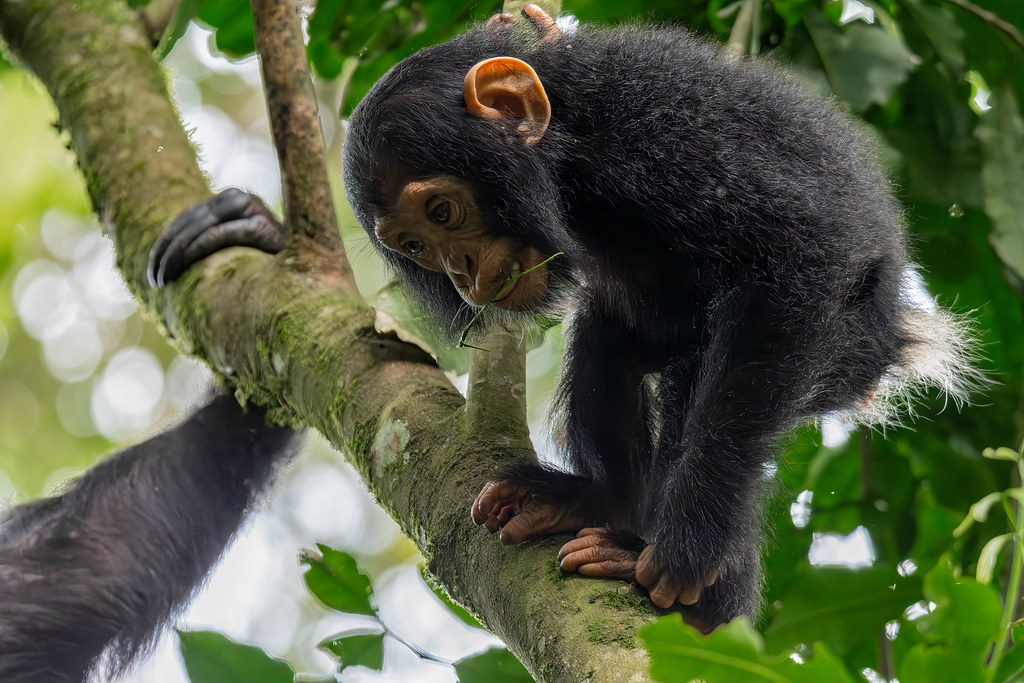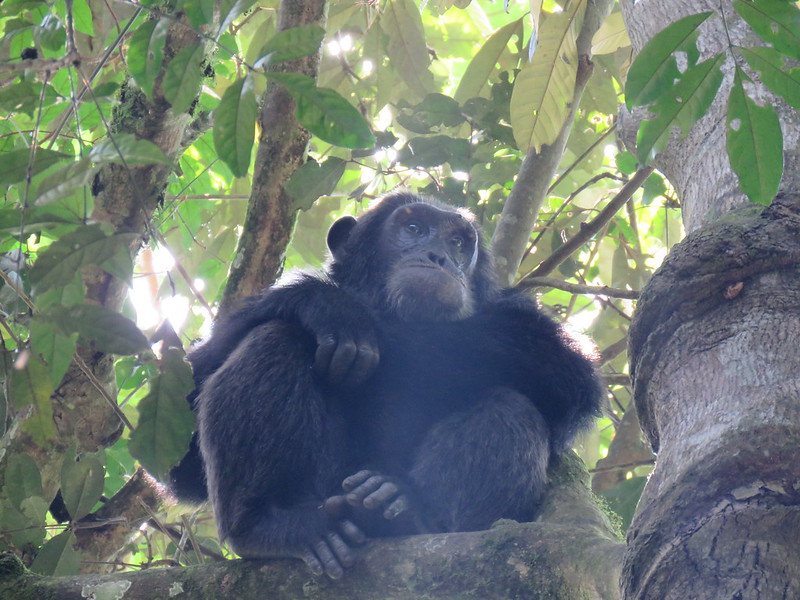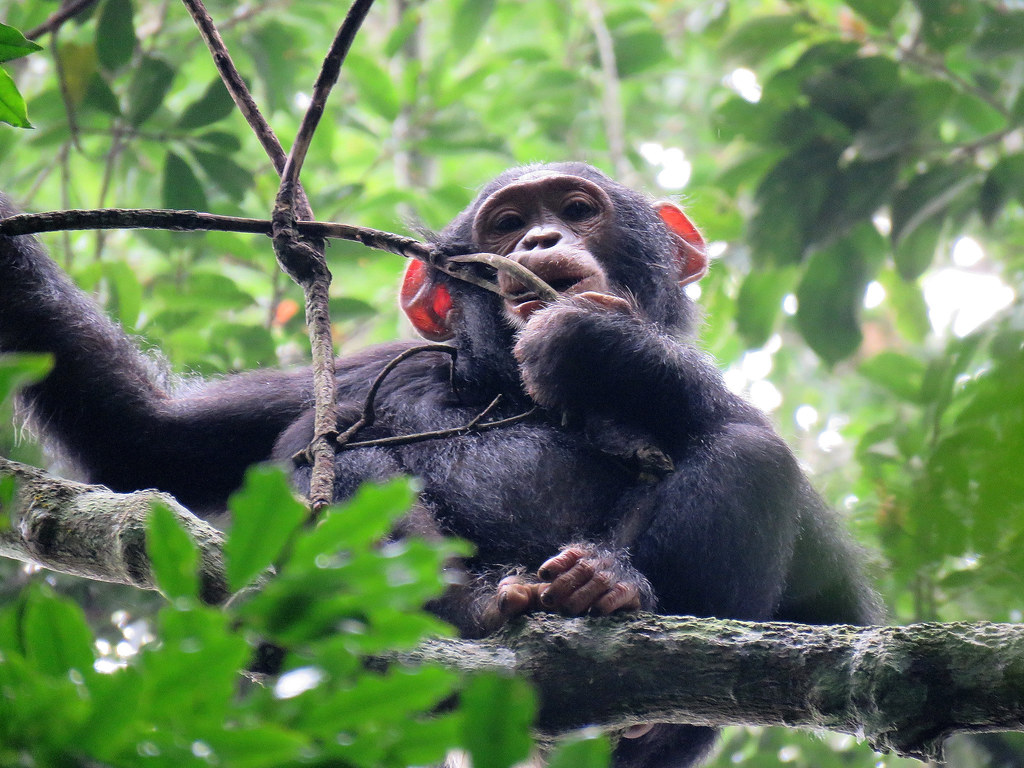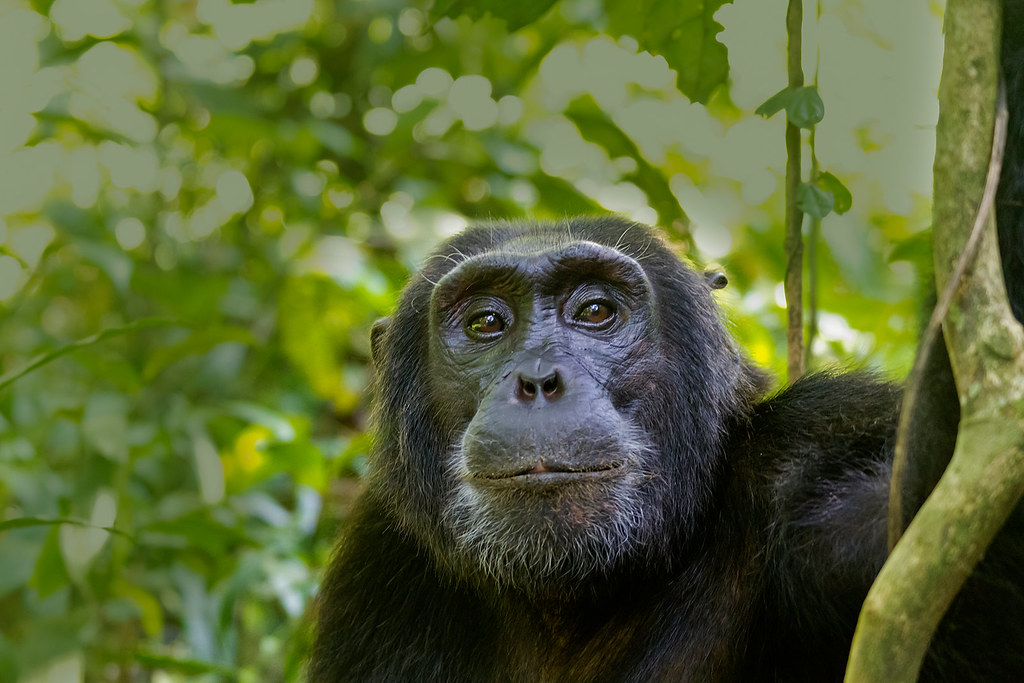Chimpanzee Facts – Diet, Food, Mating and Social life
Chimpanzee Facts , Chimpanzees, commonly referred to as chimps, are indigenous to sub-Saharan Africa. They acclimatize to many environments and can be located flourishing in rainforests, montane forests, arid savanna grasslands, and wetlands. Chimpanzees are part of the large ape family, which includes gorillas and orangutans. Chimpanzees are classified into two species: the Common Chimpanzee and the Bonobo (pygmy chimpanzee). The Common Chimpanzee is categorized into four sub-populations: the Central Chimpanzee, the Nigeria-Cameroon Chimpanzee, the Eastern Chimpanzee, and the Western Chimpanzee.
Chimpanzee Facts , Chimpanzees and bonobos are the closest relatives to humans. Biologists assert that chimpanzees, bonobos, and humans share a common ancestor that existed approximately 7 million years ago. They additionally assert that chimpanzees and bonobos diverged approximately 1 million years ago. Bonobos are confined to the Democratic Republic of Congo (DRC).

Physical Features
Chimpanzees often possess hairless faces, palms, toes, and fingers. They are clad in either brown or black coats. Common chimpanzees are larger than bonobos. Females can weigh between 27 and 50 kilograms, and males can weigh up to 70 kilograms. Despite their lower weight compared to humans, chimpanzees possess physical strength that is 1.5 times greater. An adult chimpanzee can stand upright, attaining a height of approximately 4 feet 11 inches. They may locomote on all fours or in an upright position, possessing arms that are longer than their legs. The typical lifespan of wild chimpanzees is brief. The majority attain an age of 25 years, although a minority may survive for up to 60 years. Chimpanzees in captivity have increased longevity, with some attaining the age of 70 years. With advancing age, chimpanzees have greying hair around the chin or may acquire bald patches.
Food and Diet
Chimpanzee Facts , Feeding habits of chimpanzees Chimpanzees inhabit both terrestrial and arboreal environments. They commence their day at dawn and proceed directly to locations recognized for their superior cuisine. Chimpanzees are adept climbers, utilizing their arms to leap or swing between trees. Feeding primarily occurs in tree canopies, although they can engage in foraging on the ground. Following nourishment, chimpanzees relish their afternoon slumber. The diet of chimpanzees primarily comprises fruits, stems, bark, leaves, seeds, and blooms. Although primarily herbivorous, chimpanzees also consume insects, soil, honey, and birds. Chimpanzees have been documented pursuing smaller primates and antelopes for sustenance. Their most frequent prey is small baboons, colobus monkeys, bushbucks, bush infants, warthogs, and blue duikers. They achieve this by collaborating and establishing efficient hunting groups. Meat and insects constitute merely 2 percent of the chimpanzee diet.
Intelligence
Following humans, chimpanzees are the most intelligent primates. They possess the ability to utilize diverse instruments for distinct purposes. These implements are crafted by altering rocks, wood, or grass to extract termites or insects from their mounds or to impale smaller mammals. They have also been noted absorbing water for consumption through leaf-sponges or utilizing stones to crack nuts.
In addition to utilizing tools, chimpanzees exhibit additional indicators of intelligence, such as the capacity to recall symbols and collaborate while activities or hunting. Chimpanzees possess self-awareness and are among the few species recognized for passing the mirror test. Additional indicators of intelligence include the capacity for humor, engaging in playful interactions, and providing care for an ailing group member.
Social Existence
Chimpanzees exhibit significantly greater social behavior than gorillas or any other big apes. They exhibit intricate social techniques and behaviors akin to those of humans. Chimpanzees possess the ability to build coalitions, use opportunities for personal gain, conceal knowledge that may aid others, and employ deceptive body language. Chimpanzee communities have significant political dynamics akin to those observed in human societies. Chimpanzee groups may comprise between 15 and 150 members. Individuals may organize into smaller groups for feeding, hunting, or patrolling their shared region. Despite the division of chimpanzees into smaller groups within a society, they are all acquainted with one another. They will convene to protect their shared turf.
Chimpanzee societies are typically governed by multiple males, with the dominant male exerting greater authority. The men in the group collectively assume the duties of safeguarding the group, foraging for sustenance, and patrolling the region. In contrast to gorilla communities, dominant male chimpanzees do not possess absolute authority. This is due to the considerable size and instability of chimpanzee communities. The principal man must consistently assert his dominance whenever the splinter factions reintegrate with the primary group. His reign may swiftly conclude if the other guys in the group unite to oust him. The dominant male must sustain coalitions to manage primary competitors.
Chimpanzees construct a nest in a different site each night. Each chimpanzee constructs its own nest, with the exception of mothers and their offspring.

Communication
Chimpanzees utilize several vocalizations to convey messages among themselves. These sounds are accompanied by distinct postures and facial expressions. A frightened chimp exhibits a distinctive grin to signal others. Chimpanzees may also smirk, extend a hand, crunch, or swagger to convey a certain message. Alternative communication methods encompass striking tree trunks or drumming. This technique of drumming and striking tree trunks is frequently observed when they confront another group or leopards. Chimpanzees are proficient in vocalization as a means of communication. Vocalizations such as hooting, barking, and grunting are employed for social bonding, greeting, or during feeding interactions. Chimpanzee trekking is particularly intriguing in contrast to seeing gorillas due to the talkative nature of chimpanzees. The cacophony and tumult within chimpanzee groups facilitate their detection even prior to visual confirmation.
Reproduction
Female chimpanzees attain sexual maturity at 13 years, whilst males do so at 16 years. Male chimpanzees often remain within their natal communities for life, whereas females tend to migrate to different chimpanzee communities. In contrast to men, who are perpetually receptive to mating throughout the year, female chimpanzees exhibit increased receptivity to copulation solely during their oestrus period. Oestrus occurs monthly and lasts for a duration of 10 to 14 days. Female chimpanzees display a pink swelling on their hindquarters to indicate fertility. The act of mating is a quick event, lasting approximately 6 to 7 seconds. In contrast to gorillas, the dominant chimpanzee does not possess exclusive mating privileges with the females in the group. Female chimpanzees may copulate with multiple males within the group. In contrast to gorilla communities, female chimpanzees may establish a robust attachment with a specific male who is not regarded as one of the most dominant individuals in the society. Copulating with several guys within the group guarantees the female’s support. It also diminishes the likelihood of infanticide.
Upon successful copulation, which occurs once every five years, the gestation period lasts eight months. A female typically gives birth to a single offspring. Twins are feasible, albeit infrequently. A mother will assume the majority of the responsibility for caring for the newborn, doing it with profound love and attentiveness. An infant rapidly acquires the ability to grasp the mother’s abdomen postnatally. At six months, the infant starts to ride on the mother’s back. The mother and infant will establish a strong attachment due to the extended interval before her subsequent childbirth. A female chimpanzee have ample opportunity to excel as mothers. She will instruct the infant in essential survival skills for the jungle, safeguard it from other community members, and provide emotional care. After one year, the infant will begin to cultivate tighter interactions with other community members. In the event of a mother’s death or injury, other women in the community will assume caregiving responsibilities. The child is weaned between the ages of 6 to 9 years. The mother chimp will form a lifelong attachment with her son, in contrast to her daughter. Consider exploring further information regarding gorilla mating behaviors.
Hostility and attacks
Chimpanzees exhibit greater aggression than gorillas. This is primarily due to male chimpanzees frequently collaborating to orchestrate lethal assaults on other chimpanzee populations. The instability within chimpanzee groups and societies leads to continual conflicts for dominance establishment. These confrontations are frequently savage and culminate in fatalities. Chimpanzees are known to assault human groups residing near their areas. They frequently target children and possess the ability to abduct infants. Chimpanzees are typically more erratic and aggressive than gorillas. In regions where chimpanzees coexist with gorillas, they can be seen foraging in the same trees. They infrequently vie for sustenance and will only disregard one another. Nonetheless, due to the aggressive disposition of chimpanzees, they have been documented coordinating attacks against a gorilla family.
Conservation
Historically, more than 1 million chimpanzees inhabited the deep forests and savannas of Africa. Fewer than 300,000 individuals currently exist in the wild. Their swiftly diminishing population has compelled the Tourism and Chimps International Union for Conservation of Nature (IUCN) to categorize them as critically endangered. Leopards are the primary natural predators of chimpanzees, however lions have also been documented killing savanna chimpanzees. Excluding leopards and lions, people provide the most significant threat to chimpanzees. The human danger manifests in diseases, habitat destruction, and poaching. Poaching is frequently conducted for meat and to fulfill the demands of pet traffickers or circus companies. Chimpanzees get ensnared in traps abandoned by poachers targeting other forest mammals and avifauna. These traps can mutilate chimpanzees, resulting in amputations or fatalities. Chimpanzees are utilized in laboratories for scientific purposes, as evidenced by recent Coronavirus research endeavors.

Organizations such as the African Wildlife Foundation (AWF), Jane Goodall Institute, and World Wide Fund for Nature (WWF) are diligently striving to safeguard chimpanzees in Africa. The World Wide Fund for Nature is assisting by monitoring chimpanzee populations, facilitating the establishment and management of national parks, engaging people to preserve forests inside chimpanzee habitats, and promoting international collaborations for the protection of these animals. The African Wildlife Foundation collaborates closely with people residing near chimpanzee habitats by offering incentives that promote the advantages of preserving chimpanzees for future generations. They have established conservation institutions such as Lupani School, where youth are educated on the significance of safeguarding chimpanzees and other species.
In what ways may you assist as an individual? The most effective method to support Chimpanzee Conservation is by contributing to organizations such as the WWF or by observing chimpanzees in their natural habitats in Africa. Tourism has significantly contributed to the advancement of primate conservation efforts. Revenue generated from tourism is allocated to patrolling chimpanzee habitats, constructing necessary infrastructure, and compensating personnel tasked with safeguarding the monkeys. When a community derives advantages from tourism, they are less inclined to hurt the chimpanzees or devastate their habitat. Tourists contribute to the promotion of primate conservation, exemplified by mountain gorillas. It is widely believed that mountain gorillas would likely be extinct without tourism.
Where to see chimpanzees
The central chimpanzee is the most prevalent species, with a population exceeding 110,000 individuals primarily residing in Angola, Congo, Gabon, Cameroon, Nigeria, Equatorial Guinea, and the Central African Republic. Eastern chimpanzees inhabit the Central African Republic, Uganda, Rwanda, Tanzania, South Sudan, and the Democratic Republic of Congo. Western chimpanzees inhabit Senegal, Nigeria, Côte d’Ivoire, Guinea, Ghana, Guinea-Bissau, Mali, Liberia, and Sierra Leone. The Nigeria-Cameroon chimpanzee, comprising approximately 6,400 individuals, is the least populous species.

The optimal countries for observing chimpanzees in their natural habitat are Uganda, Tanzania, the Democratic Republic of Congo, and Rwanda. Chimpanzee trekking in Kibale National Park is notably favored. However, one may contemplate chimpanzee tracking at Nyungwe National Park or Virunga National Park in the Congo. An excellent paper regarding chimpanzee tracking in Tanzania is available. The Ngamba Chimpanzee Sanctuary in Uganda invites volunteers and those interested in observing efforts to safeguard chimpanzees. Uganda provides greater diversity than any other chimpanzee trekking location. Visitors can also monitor chimpanzees at Budongo Forest within Murchison Falls National Park, Kalinzu Forest, Semuliki National Park, Maramagambo Forest, and Kyambura Gorge in Queen Elizabeth National Park. An age restriction for Chimpanzee trekking exists, contingent upon the specific location of the activity.
